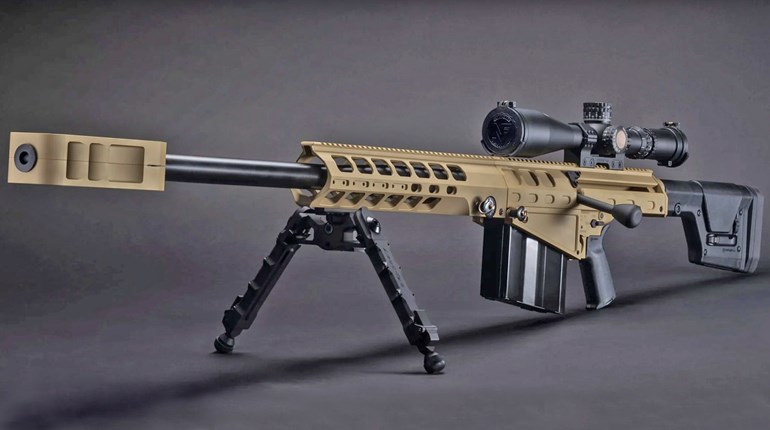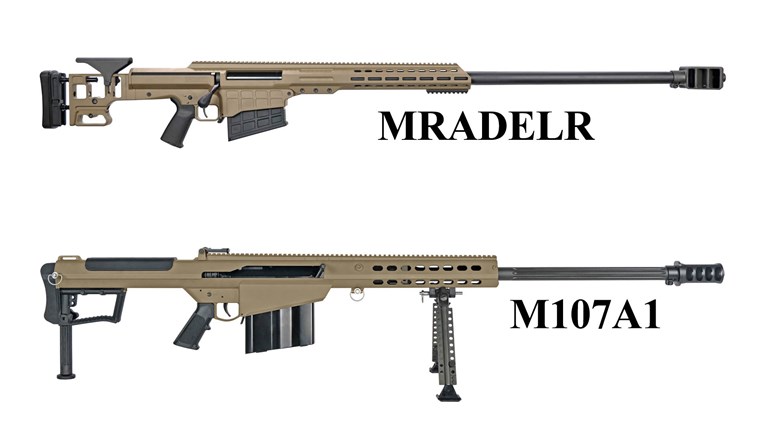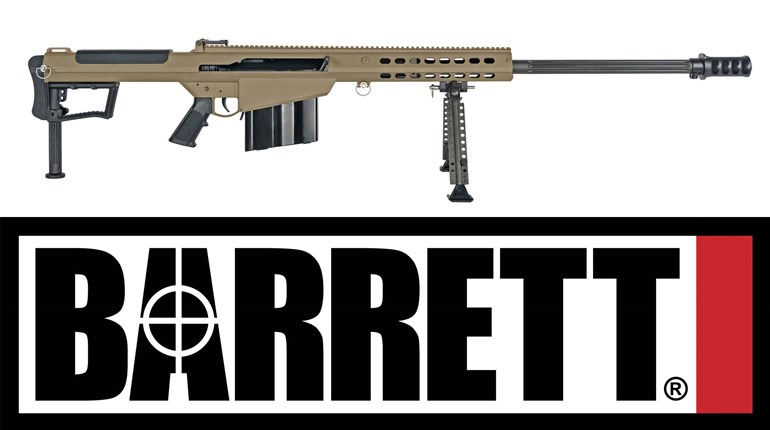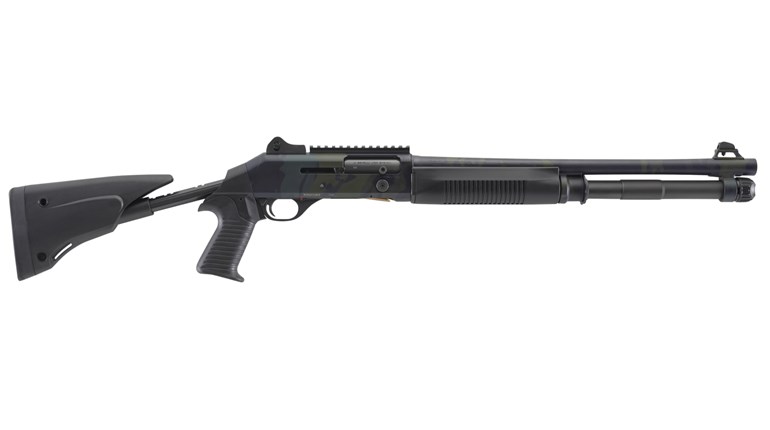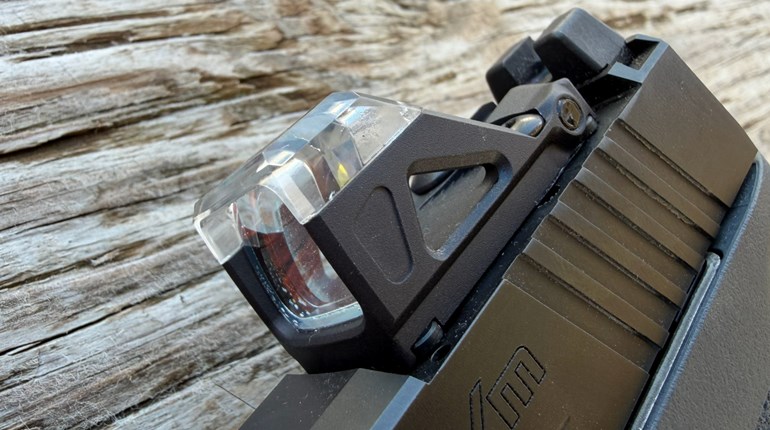
Lifting the lid on the tan rifle case, I viewed the contents with an equal mix of awe and apprehension. Inside lay two massive assemblies of steel, aluminum and titanium, with a half-inch hole running clear through one of them. As I skimmed the green-covered manual and joined the two halves of the Barrett M107A1, one of the company's .50 BMG semi-auto rifles, a small crowd of coworkers gathered.
"What are you going to do with that?" one of them asked.
"Shoot it," I deadpanned, trying to make it sound as though unleashing 10,000 ft.-lbs. of energy from the muzzle of a 30-pound rifle was as natural to me as swigging sweet tea on a hot day. In truth, I was excited and, yes, perhaps a bit intimidated by what the following week would bring.

A few months earlier I had contacted Barrett about signing up for the company's Long Range I and II courses. Soon after the Barrett M107A1 arrived, I found myself headed for a six-day "man-cation" (as one of my married friends calls a testosterone-laden trip away from the wife and kids) in the wide-open spaces of the NRA Whittington Center near Raton, NM.
Previous conversations with the company provided me with plenty of details regarding what the courses would cover. The bottom line was I'd be shooting approximately 300 rounds of .50 BMG over six days from a variety of positions at targets up to more than a mile away. Sounded like fun, obviously, but I still wasn't sure what to expect. Or more accurately, I wasn't sure what to expect of myself.
I had fired .50 BMG rifles a handful of times, but the round count for the courses would far exceed what I had tallied in the past. Then there was the question of extreme distance. Before I enrolled in the Barrett courses, I had shot at a target a mile away exactly four times. Was I about to get in over my head? And how many rounds would it take before that head, along with the shoulder below it, started pounding from the effects of recoil? Those questions loomed larger than the Barrett M107A1's muzzle brake as I made my way to the "Eagle's Nest," the metal building adjacent to the Whittington Center's 1,000-yard rifle range that would serve as classroom and command center, for the first day of training.

Turns out I had nothing to fear but plenty to learn. Some of the points made by the instructors came as a surprise, while others simply invoked good sense. Not only did the training provide a better understanding of the characteristics and capabilities of Barrett's .50-caliber rifles, like the Barrett M107A1, it also helped develop a solid foundation in extreme-range shooting. Whether you are wondering what it would be like to shoot a .50 BMG or are looking to improve your skills, any of the following tips from Barrett Long Range I and II is solid advice.
Recoil is manageable.
Even though the .50 BMG creates a tremendous amount of projectile energy at the muzzle, most shooters won't have much trouble handling felt recoil. The Barrett M107A1 has at least two features that helps you control it while firing.
First, Barrett guns are really heavy rifles, weighing from about 24 to 30 pounds, depending on the model. Weight is your friend in this case, because it slows the velocity at which the rifle accelerates rearward upon discharge. Also helping lessen felt recoil is the telltale muzzle brake found on .50-caliber Barrett rifles. Baffles in the brake direct propellant gases rearward, which in effect pulls the rifle forward, partly countering recoil. The semi-automatic M82/M107 family has a third feature that reduces kick; the recoil-operated action spreads the impulse over a longer period of time, which further softens the blow to your shoulder.

Everyone perceives recoil differently, but most shooters liken felt recoil from a Barrett M107A1 .50 to a long, deliberate push on the shoulder, as opposed to a sharp, erratic jab. It's difficult to compare to the recoil from any other firearm because of the extended duration of the push, but to me, the force feels similar to a 3-inch magnum load fired from a 12-gauge shotgun, only drawn out twice as long. You're going to go for a ride, but that doesn't mean it's going to be painful.
What takes more time to get used to is the compression wave, or concussion, generated by the muzzle brake. It feels like someone is pressing their palm to your forehead and, since it comes about the same time as the rifle starts to recoil, can be a bit disconcerting at first. While it doesn't hurt, it does come as an abrupt surprise. The best way to deal with it is to concentrate on follow-through. The sensation passes quickly, and it's just a byproduct of a very necessary feature hanging on the end of the barrel.
Body position is critical.
The position of your body relative to the rifle when firing prone is not only important to managing recoil, but it also plays a vital role in accuracy. "Your body needs to be straight behind the rifle to absorb recoil and to prevent the muzzle brake from torquing the rifle away from your body, which will affect point of impact," said Barrett instructor Cody Carroll.
He went on to explain that as the bullet travels through the bore toward the muzzle of the Barrett M107A1, it forces the column of air in front of it through the brake. If your body is angled to the side, the air flowing through the highly efficient brake could cause the rifle to twist or cant before the bullet leaves the bore, resulting in a projectile that deviates from the intended path. In addition, Carroll stressed it is essential to apply a positive load to the bipod with force along the axis of the bore when shooting prone. You want to lean into the bipod as you settle into position.

"Drop behind the rifle like you're doing a pushup," he instructed. "Arch your back, put the rifle to your shoulder, and then lower your upper body to the ground."
Fundamentals still apply.
Barrett .50s are big rifles, and I found out it's all too easy to get sloppy with your technique when firing them. Aligning your eye with the scope, controlling your breathing, establishing natural point of aim, smoothly pressing the trigger and following through after the shot are all critical when shooting .50-caliber rifles like the Barrett M107A1 at long ranges.
While you should adhere to each of these marksmanship fundamentals during every shot, natural point of aim deserves extra attention. Muscular control, especially with a 30-pound rifle, is insufficient to provide a stable platform for shooting, Carroll explained. Relying on non-muscular support from the skeleton, ligaments and other tissue eliminates changes in aim due to muscle fatigue. It also minimizes the shaking associated with muscle tension.
To find your natural point of aim, first establish your sight picture. Then, close your eyes, relax your body, inhale deeply and exhale. Open your eyes and recheck your sight picture. It should be exactly the same as it was before you closed them. If it has changed, you have not found your natural point of aim. Make slight adjustments to your body position and repeat the process until your sight picture remains the same.
"Trying to muscle the crosshair to your point of aim will not yield good results with these rifles at long range," said Carroll.
Field positions are possible.
Many shooters restrict .50-caliber rifles to the prone position. But, as Carroll put it during Long Range II, "You can actually fire the Barrett M107A1—this big ol' rifle—in the field from different positions."

A few tricks and tools help make it happen. The first thing you need is a way to support the Barrett M107A1. Carroll demonstrated that a solid stump or rock will do the job, but they aren't always available. To be sure you have support, carry it with you. Carroll prefers a sturdy tripod with a ball head and clamp that fits the rifle's fore-end. Clamp the rifle in place, then work on supporting your body.
Whether you choose to sit or kneel behind the tripod, use your pack and small sandbags to support your joints. If you're sitting, assume a cross-legged position and jam sandbags between your ankles and lower legs. Put your pack in your lap to support your elbows, or rest them on your knees. Use the reverse-kneeling position when the Barrett M107A1 is supported by a tripod, so the strong-side knee can support the strong-side forearm. Again, place sandbags in unstable areas, such as between the weak-side ankle and the ground. You can also kneel on both knees, jamming your pack in the "kneepits" between your butt and your heels.
Carroll also used a loop of tubular nylon to fasten the fore-end of the rifle to a tree trunk via a tension wrap. Tilting the rifle away from the trunk provided several seconds of sturdy support that allowed firing from a standing position.
It's not a magic cartridge.
The .50 BMG delivers impressive ballistics, but it's not immune to the effects of gravity and wind. For example, the 661-grain bullet in the M33 ball load, fired from a 29-inch-barreled Barrett M107A1, has a muzzle velocity of approximately 2,750 fps. If the rifle is zeroed at 300 yards, that 661-grain bullet will drop 6.4 mils—or more than 19 feet—at 1,000 yards. In a 10 mph, full-value crosswind, it will drift 1.4 mils—or almost 8.5 feet—at 1,000 yards. Both are enough to make you miss by a wide margin if you don't accurately correct for elevation and wind.A white sheet of steel 4 feet high and 6 feet long stood halfway up a ridge above the high power range at the Whittington Center. Carroll had ranged it at 2,450 yards. Hitting it required an elevation correction of more than 31 mils—almost 190 feet! But with that adjustment and luck keeping the wind constant, it could be hit repeatedly.

"Everyone in our classes wants to ring that target," Carroll said. "And everyone will, as long as they have the right dope and pay attention to the fundamentals."
Ammo affects accuracy.
In fact, other than the shooter's skill level, ammo may be the weakest link in the .50 BMG system. The most readily available and least expensive .50 BMG load is M33 ball. Unfortunately, M33 is intended for use in machine guns, and it's far from the most accurate fodder you can feed a .50-BMG Barrett M107A1.
The M107A1 I shot during the courses was a 2.5-MOA rifle with M33 ball. But with Barrett Accuracy Ammo, loaded to stricter tolerances with a 647-grain Barnes bullet, I got repeated 1.5-MOA groups. If you're looking for the utmost accuracy from your .50, it pays to shoot match-grade ammo.
These are the type of lessons you learn only after spending a good deal of quality time with a Barrett M107A1. Those of us who don't own a .50 BMG, or don't have the time or space to shoot it extensively, can tap into the wisdom held by the guys who do. Barrett's Long Range I and II courses make it possible, and spending three or six days shooting .50-caliber rifles is a blast—literally.













